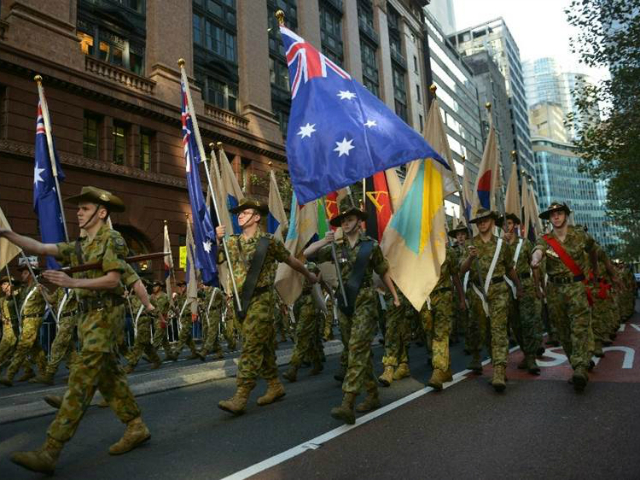Some 3,000 Australians marked Anzac Day on Monday with a sombre dawn service in northern France to honour their forebears who fought in the Battle of the Somme a century ago.
“Today we come together… to commemorate all who served on the Western Front and to remember those who never made it home,” Australian Air Force chief Leo Davies said.
The faces of the fallen were projected onto the imposing tower of the Australian National Memorial, which honours nearly 11,000 soldiers with no known graves.
A sole bagpipe wailed as dignitaries including French Defence Minister Jean-Yves Le Drian and the governor general of Australia, Sir Peter John Cosgrove, laid wreaths at the monument of the cemetery at Villers-Bretonneux.
“The presence of so many of you underscores the strength of our friendship,” Le Drian told the crowd, which also included scores of French people.
Doug Morgan, music director at Saint Peter’s College in Adelaide who led 50 students to the event, said: “We’ve had amazing reception here. The local people are very hospitable, and still very grateful for what the Australians did.”
The Battle of the Somme, which lasted nearly five months, saw more than a million casualties on both the Allied and German sides and came to symbolise the futility of World War I.
Each of the 141 days of trench warfare took an average toll of some 8,500 casualties, but for all that the Western Front shifted no more than a few kilometres.
For the Australian volunteers, the sacrifice began with a sea journey lasting up to four months.
The spirit shown by the Anzac troops has long been seen as critical in forging a national identity in Australia as well as in New Zealand, both fledgling nations at the time.
Anzac Day commemorates the landing of the Australian and New Zealand Army Corps (ANZAC) on the Gallipoli peninsula on April 25, 1915, at the start of an eight-month campaign against the Ottoman Empire in which 8,700 Australians and nearly 2,800 New Zealanders died.
The battle of Gallipoli, in modern-day Turkey, is generally seen as a devastating military failure for the Allied powers against the German-backed Ottoman forces, who managed to resist the attempts to break through towards Constantinople.
Now synonymous with valour, Anzac Day is a public holiday in both Australia and New Zealand, also honouring veterans from other conflicts, including South Korea, Malaysia, Indonesia, Vietnam and Iraq.
– ‘Hell on earth’ –
Held across Australia, the Anzac dawn service has its origins in a military practice known as “stand-to”, in which soldiers are woken before dawn to avoid the vulnerability that comes with the early light, which is notorious for playing tricks on the eyes.
“It was emotional, and it was quite educational to learn about what the Australians did on the Western Front,” said Craig Rogers, an Australian defence researcher, after the ceremony.
“Coming out on a morning like this in the cold is a small sacrifice compared to what those people did for us.”
The history also runs deep in the community in northern France where so many lost their lives.
“My father was born in a village near here,” said Jean-Louis Delauney, whose grandfather survived a chlorine gas attack during the Battle of the Somme. “My whole childhood was affected by World War I.”
Monday is the 98th anniversary of the battle that liberated the town of Villers-Bretonneux, near Amiens.
“It puts it all in perspective to come here,” said Australian Peter Crowle, 69, whose grandfather died in the battle. “The conditions they were subjected to were hell on earth.”

COMMENTS
Please let us know if you're having issues with commenting.